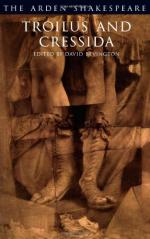|
This section contains 9,380 words (approx. 32 pages at 300 words per page) |

|
SOURCE: "Unbodied Figures of Desire," in Theatre Journal, Vol. 38, No. 1, March, 1986, pp. 34-52.
In the following excerpt, Cook examines the problematic relationship between desire and the representation of women as objects, which she claims "requires that the woman either betray her lover, revealing her inadequacy in her corruption, or die. "
In the scene in Troilus and Cressida which brings the lovers together, just prior to the consummation of their union, Troilus articulates a radical asymmetry at the heart of desire. This skewed relation between desire and its objects infects both the masculine enterprises which drive the play—his own quest for satisfaction in "Cressid's love," and the Greeks' and Trojans' competition for the "inestimable" prize of Helen:
This is the monstruosity in love, lady, that the will is infinite and the execution confined; that the desire is boundless and the act a slave to limit.
[III. ii. 82-...
|
This section contains 9,380 words (approx. 32 pages at 300 words per page) |

|


